
Intro: I’m going to review 3 new chess books on the French defense. The goal is to inform the reader of the content of such books, so they can decide how to spend their hard earned money, and at the same time to make it a training-teaching moment for the reader and myself. The different games coming from these books will show patterns and ideas we do need to know, if we want to play the French. Yes, it will be a lot of material to read, but that’s the answer to those who continuously ask how to improve in chess: it takes a lot of hard work! This article itself, since I wanted to know why some games went bad, took me a lot of hard work and more than 2 months. Of course I like also to have fun, so the review will be entertaining, obviously entertaining in a chess sense, games like Predojevic vs Morozevich reminds us of forgetting to memorize opening theory or to forget to follow some sterile chess laws, and use our heads, because then only then a defense like the French becomes a knife to use to gut our opponents over the Board!
Last month I wrote an article showing the games of an exciting match between Fat Fritz 2 and the Magnus play app (whose advertisement boast it’s like to play versus Magnus! – https://chessnewsandviews.com/fat-fritz-2-versus-magnus-carlsen/).

From the idiotic conspiracy theorists we can find everywhere in our modern society, but especially on Facebook, I was immediately labeled as a Chessbase sold out, also if my site is based on the work of a very lazy web master, whose only goal in life is to become a US Chess National Master playing 1…a6 (now he changed version, he wants to reach 2000, I wish I could give him 300 of my points!) some chess friends who luckily help me from time to time, and myself writing articles.
Now I’m publishing this review for an Everyman Chess book, and I’m sure the same conspiracy theorists will label me as a sold out to Magnus who actually bought the entire publisher!! (or at least that was what I heard of)
So it’s better to be clear: Magnus didn’t send me a check, he didn’t promise to play 1000 bullet games on Lichess, or to give me one hour lesson… he didn’t even want to give me the phone number of his sister…
But if the web master is reading this article: “it’s 2 months I told you to put a Patreon button on our page, or an advertisement for letting everyone know they can send me a Lamborghini for my birthday… plus some money for gas!“

Coming back to real chess which is the main reason for living and having a life! Why did I get this book? Because I ascribe to the chess school of thought which says that in order to become good players one needs to see a lot of annotated games, eventually comment and analyze them by himself etc. The goal is to acquire a lot of patterns which we will later use in our own tournament games. Obviously this is a very simplified version of what such school of thought says but more or less this is the gist of it.
The problem is that the common amateur doesn’t know what to look into a game, so it’s necessary to have a mentor who guides us through the chess jungle of different openings, tactics, patterns and ideas one must know.
In the beginning of the book GM Lemos mentions this is not a repertoire book, and this is another of the reasons I got it, because I want to gain an understanding of the main ideas of the French in order to be able to comment and understand games played with the French opening when I’ll watch them by myself, without a GM guiding me.
The book begins with a chapter on sidelines, and I think this approach is quite logical, because when few years ago I tried to play the French thanks to another Chessbase DVD https://shop.chessbase.com/en/products/pert_french_defence_for_the_tournament_player, the first thing my opponents did was to go into sidelines I didn’t study well, because I thought rare, and that threw me off balance (an euphemism which means I lost many games!).
The first chapter shows 1.e4 e6 2.d4 d5 3.Bd3, while the rest of the chapter deals with 1.e4 e6 2.Nf3. Here some of the games given in this chapter.
However there are other sidelines which are not treated for example using my Megabase 2021 (just to be sure I trigger the conspiracy theorists, I’ll add the link to the Chessbase page! https://shop.chessbase.com/en/products/mega_database_2021) I found the move 1.e4 e6 2.Qe2 has more than 7000 games!! (Let’s not forget that it’s possible to transpose into the King’s Indian Attack with this move. There is a game in chapter 9 which shows that)
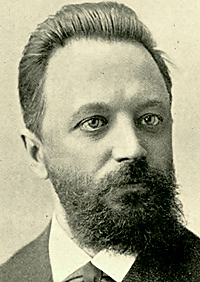
We can also notice in these games from over 100 years ago, how top players of the time fell for common tactics. It happens also today but in blitz, in that time the time controls were longer, so it’s not really understandable. One of the games I saw had the time stamps, and it lasted 6 hours.
One could ask why watching them, because they show small advantage conversion into the endgame, often rook endgames, and how they won them. Yes, after the opening one still has to survive the middlegame and eventually win in the endgame.
As shown previously, I look for top games clicking on the Elo tab, refer to this article to see how to do it (https://chessnewsandviews.com/how-to-study-the-openings-part-1/. I found out many top players used such line, here a sample of the games:

Yes, this is the part the silly conspiracy theorists missed. Today a serious player cannot really prepare without Chessbase, and to find those 7000 games took me less than 1 minute. Of course many of these conspiracy theorists don’t understand much about chess and preparation. In the 1970ies or 1980ies, before Chessbase, in order to find those 7000 games I found with few clicks, would have taken days, hoping one had an entire chess library, with the collection of the Informator and decades of chess magazines.
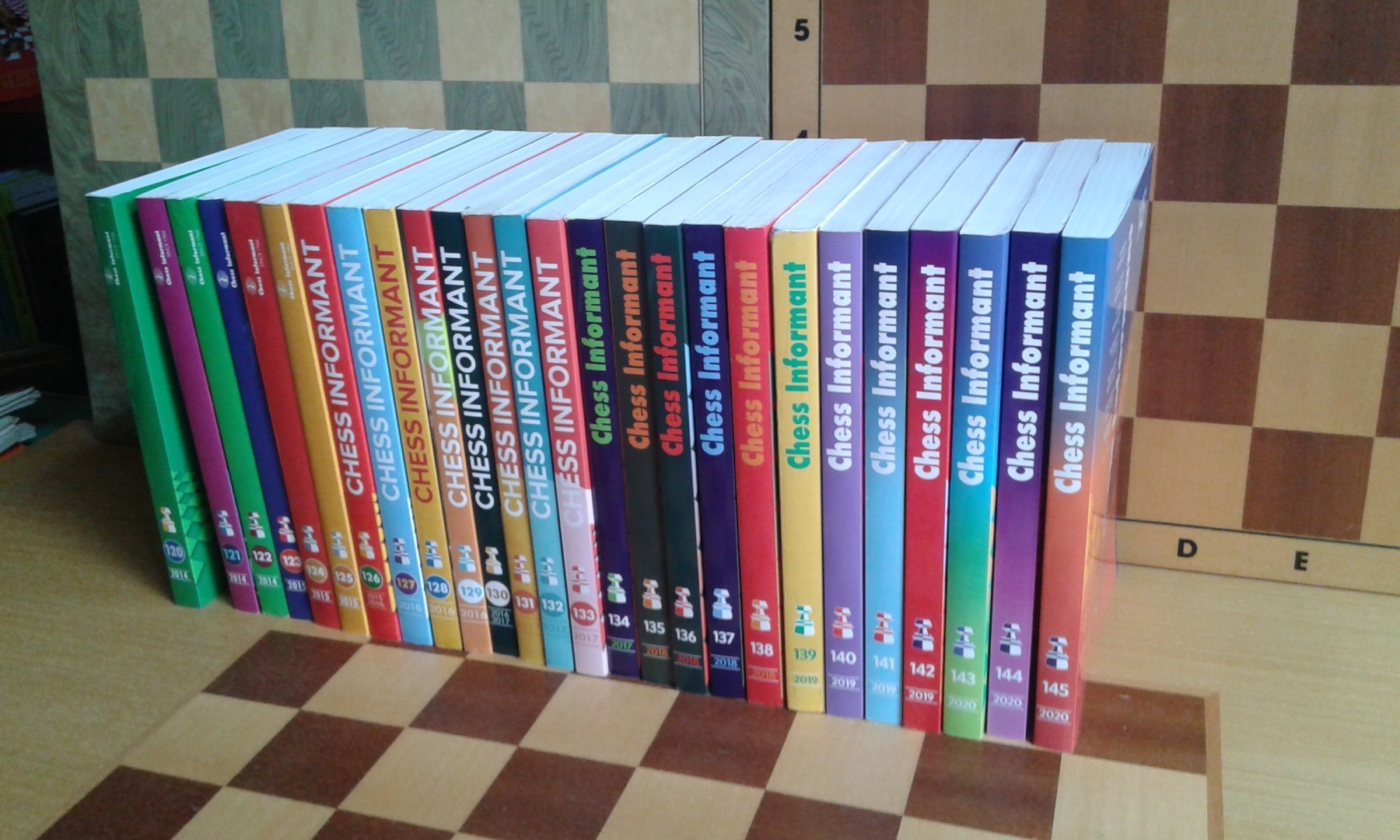
Of course there are also some other sidelines, which resurfaced recently, because now due to the pandemics we have played blitz ad nauseam, and there was the need to surprise the opponents with something which maybe is not great for long time controls, but which can be great to throw off an opponent when even seconds matter.
The book in total is made by 9 chapters, let’s make a list of what they treat, and show some of the games without annotations for each chapter, so the future reader of the book can get a feeling for the content, analyze the games, and see the depth and understanding difference with the way GM Lemos explained them.
Chapter Two: the Rubinstein Variation, honestly when playing as White against the Rubinstein in tournament, I truly had some easy wins. As Black I did lose badly, or had to defend for long time. GM Williams also a French practitioner, comments negatively on the Rubinstein. But what is the Rubinstein? After the usual moves: 1.e4 e6 2. d4 d5 White can play 3. Nd2 (Called Tarrasch Variation of the French) or 3.Nc3, if Black is lazy and doesn’t want to prepare he will answer with: 3…dxe4.
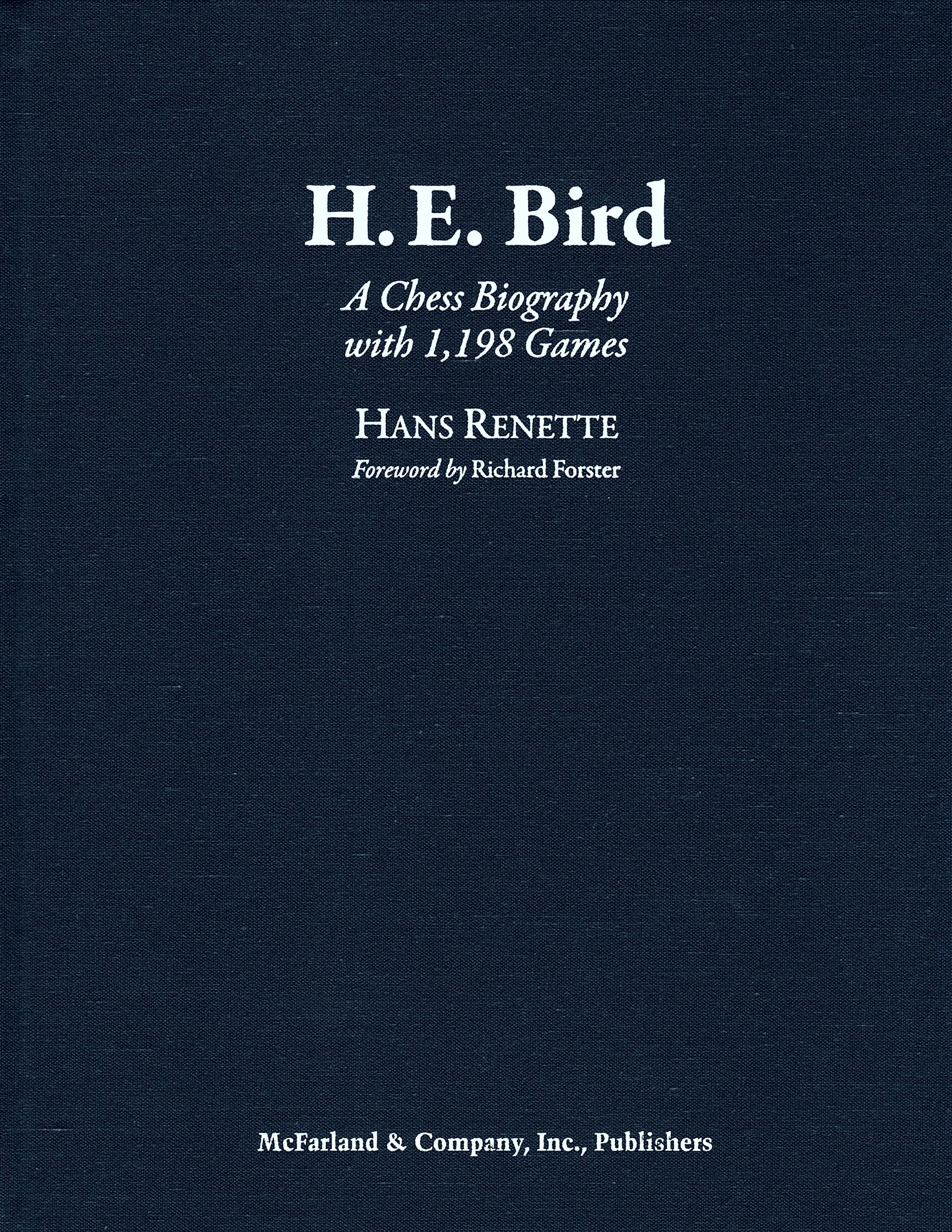
Also if called Rubinstein many famous players played this line quite before Rubinstein, one of them is H. Bird, in a match against World Champion Steinitz in 1866, here their games:
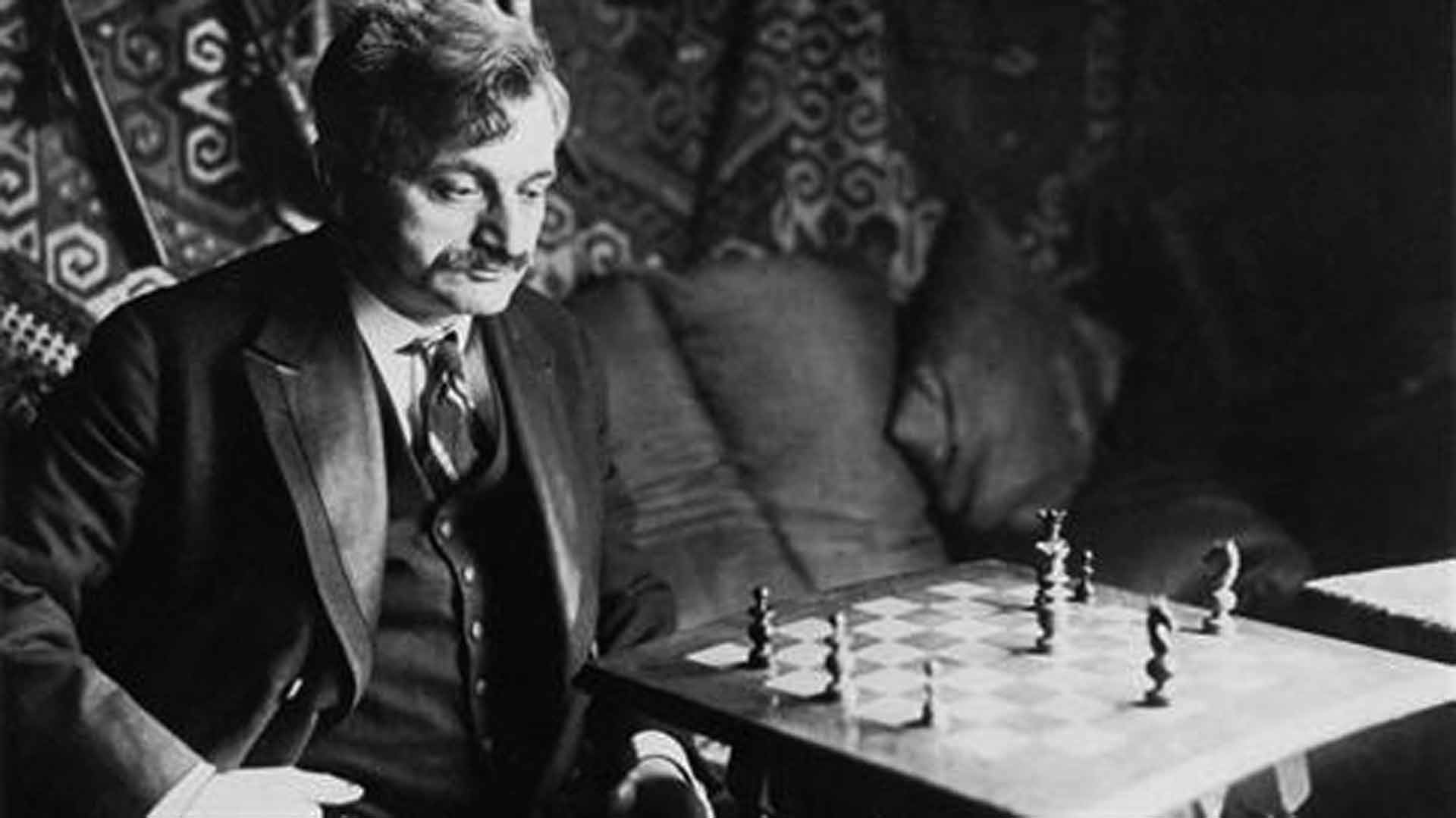
In the match for the 1894 world championship between Steinitz and Lasker, the future world champion Lasker did use such opening, and he even won the game! Why such game is important? Because I found this game as annotated by Steinitz (and it wasn’t inside Megabase 2021 https://shop.chessbase.com/en/products/mega_database_2021) in which Steinitz claims this opening was first used by Bauer in a minor Vienna tournament!
Here the game to which Steinitz is referring to:
Obviously those of us using Megabase 2021, will immediately spot games played before 1890, in which the idea Nbd7 was used. Steinitz wasn’t lucky like us, having access to over 8 million games with few clicks.
But before Rubinstein we do have games played by Capablanca and Nimzowitsch with 3…dxe4. While the first games played by Rubinstein with this move are from 1907:
Knowing the history of this line may not be important for a tournament player in 2021, watching the games above gave us an idea of how it was played in the past. Now we can see the games selected by Lemos for this chapter, and make a comparison, then of course for those who’ll buy the book, they will be able to see the annotations, and better understand how the Rubinstein is played today:
We have the Burn variation after the moves: 1.e4 e6 2.d4 d5 3. Nc3 Nf6 4.Bg5 dxe4

Lemos in this book doesn’t cover the Classical which we have after the moves: 1.e4 e6 2.d4 d5 3. Nc3 Nf6 4.Bg5 Be7

Lemos also doesn’t cover the McCutcheon which we have after the moves:
1.e4 e6 2.d4 d5 3. Nc3 Nf6 4.Bg5 Bb4


Amos Burn a player from the late 1800, did play many games with this line, here some of them:
Here the games of this chapter
Chapter Four: The Steinitz Variation
We have the Steinitz line after the moves: 1.e4 e6 2.d4 d5 3.Nc3 Nf6 4.e5 Nfd7 and like Lemos points out generally

White plays 5.f4 and 5.Nce2

But since this line of the French is called Steinitz, the name of the first world champion, I began to look in Megabase 2021 for games played by Steinitz, and try to understand how he played. It seems he was quite successful, because out of the 9 games I found, Steinitz won 8 and drew 1.
As the reader can see the advantage of owning Megabase 2021 (https://shop.chessbase.com/en/products/mega_database_2021) is real, some of the games are annotated by Steinitz or other great players from the past.
Now let’s see which games were selected for this chapter:
A useful exercise would be to find in all these games the critical moment when White or Black lost, and print the diagram, writing behind why it was critical and what was the correct continuation. This will create a chess library of positions we memorize for this opening, helping us develop the understanding of the opening.
Chapter Five: The Winawer Variation
We have this line of the French after the moves: 1.e4 e6 2.d4 d5 3.Nc3 Bb4 4.e5

Notice the importance of 4.e5 because if White plays 4.exd5 followed by 4….exd5 then we have the Exchange French. As done previously I’ll show some games from when this line was played first, in this way it’s possible to make a mental comparison between those times, and the games selected by GM Lemos. Then of course, if one wants to learn, he needs to get the book, and see what GM Lemos is actually conveying through the exercises and questions he poses.
Please notice some evaluations given in the game Lasker vs Maroczy for some moves are not correct, while some others are spot on. Yet it’s quite interesting to see how a GM from the 1970ies evaluated the position.
The game Romanovsky vs Rabinovich is a masterpiece for understanding the pin tactical element.
Now that we have seen some amazing games from hundred years ago or more, let’s see the selection of games chosen by GM Lemos. The game Kasparov vs Ivanchuk is quite interesting, because it seems Ivanchuk is playing a hippopotamus defence, by the way in 1995 they played 5 games, this is the only one won by Ivanchuk. However this game selected by Lemos shows the importance of buying the book to better understand Ivanchuk’s ideas behind his moves.
I hope you saw the Tal vs Taimanov a tactical slugfest, and at the end, once the dust is settled, only one is still standing! As we can see, just the selection of games made by Lemos is worth the price of the book!
Chapter Six: The Tarrasch Variation
We have the Tarrasch after the moves: 1.e4 e6 2.d4 d5 3.Nd2 and now Black needs to continue with 3…c5 favorite by GM Lemos

Or Black can continue with 3…Nf6 or 3…Be7 or 3…a6, but remember if Black continues with 3…dxe4 then we have the Rubinstein which was treated previously.

Here some of the early games played by Tarrasch with his new move! As we can see there is something wrong in opening the E file for White, when as Black we have a backward E6 pawn which blocks our development, and which gives White a clear point to attack, but also the related kingside weakness is well illustrated in Tarrasch’s games.
We can also find a little naïve Black’s attitude in not asking himself what would happen when some choices are made… after all we know pawns cannot move back!
You’ll surely notice how Tarrasch is given problems when someone doesn’t open the F file and makes the E pawn weak, like in the game with Von Scheve. For example do you see why White cannot take on D6?

And then of course there is the contrast with how modern games are played. Here the selection of games for this chapter by GM Lemos.
Chapter Seven: The Exchange Variation
In the beginning of my chess learning I heard more than one time the French exchange was a drawish line (1.e4 e6 2.d4 d5 3.exd5). Unfortunately the more I played chess, and more I discovered such idea was naïve at best. At page 218 GM Lemos writes: “despite its innocent appearance, the Exchange variation is full of nuances and ideas of which both sides should be aware.” Clearly this is one of the most important chapters to study.
Let’s see the game Lemos has selected for this chapter, please notice how Marin destroys one of top women chess players in France, and how Kramnik schools the best woman player of all times: Judit Polgar, in both sides of the French exchange!
And let me do some advertisement for a book which every player who wants to play the French as Black should buy!

Alex Fishbein: “The Exchange French comes to Life, fresh strategies to play for a win.”
This book is a repertoire for the White side, and as such every player using the French as Black needs to study it, and be ready to neutralize the weapons given by GM Fishbein to White!
Another way a French defense player can prepare, is through watching GM Fishbein’s games in the French.
Here the games I found in Megabase 2021, obviously there could be some transpositions from other openings, like then Queen’s Gambit, so the reader of this article is invited to do his homework too! Notice that Fishbein with the French Exchange has won the legendary Boris Gulko, author of many interesting chess books.
These games also show how Fishbein plays well the endgame.
Fishbein_exchange_french.pgn
Chapter Eight: The Advance Variation
For this line of the French there are immediately some players who come to mind. Yes, in order to know an opening, we do need to know who are those who proposed such line publicly, and wrote about it.
The first one is GM Sveshnikov, famous also for his monograph on the c3 Sicilian, and playing it with good results all over his long career.
Sveshnikov has played more than 150 games with the French Advance, hence if one really wants to learn the French as Black, he needs to watch his games, because he will learn all possible ideas tried against Black, but most of all the different pawn formations within the French advance. Honestly just studying this chapter, made me regret I didn’t learn the Sicilian, because the French Advance shows a complexity which can arise in terms of pawn structures, and different strategic maneuvers, which is as vary as the Sicilian. Here a visual which will scare some, and show some how serious they need to be, if they really want to learn and improve in chess!

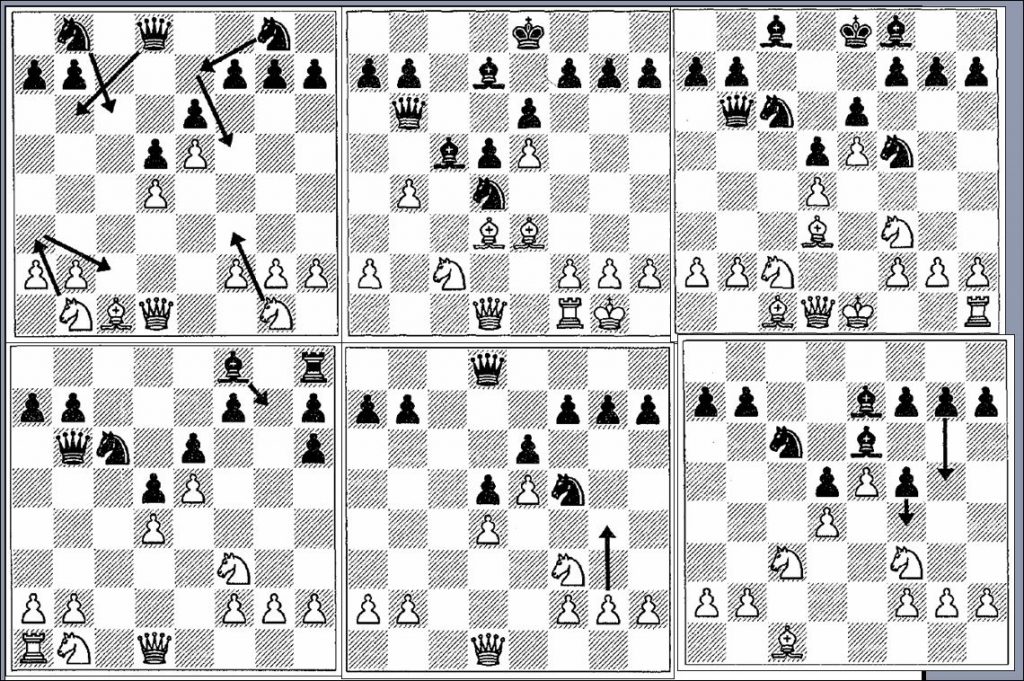
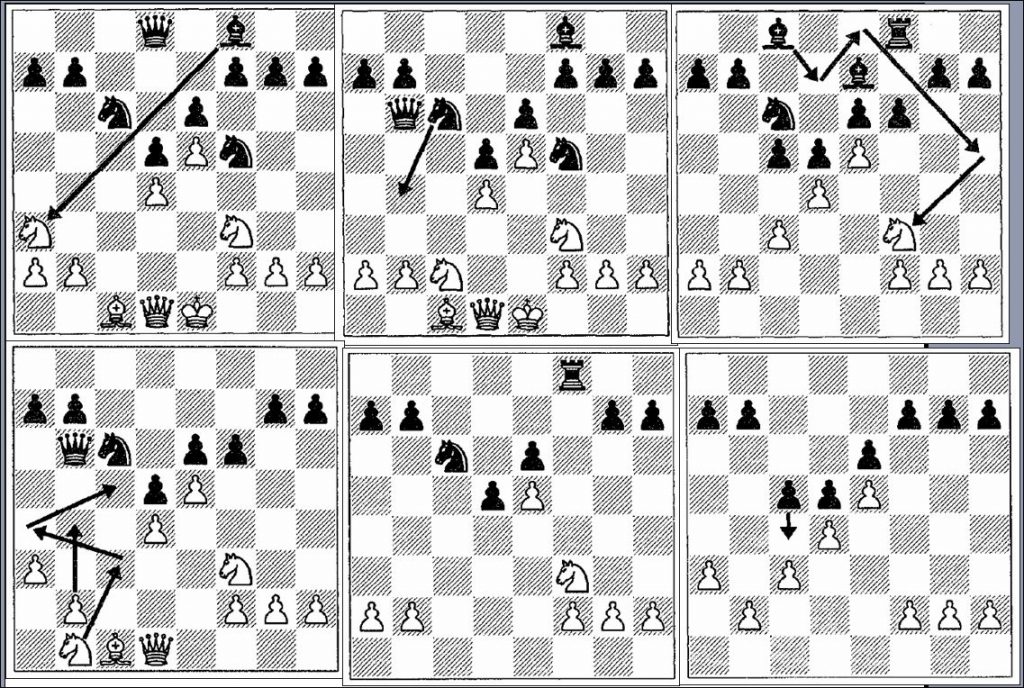
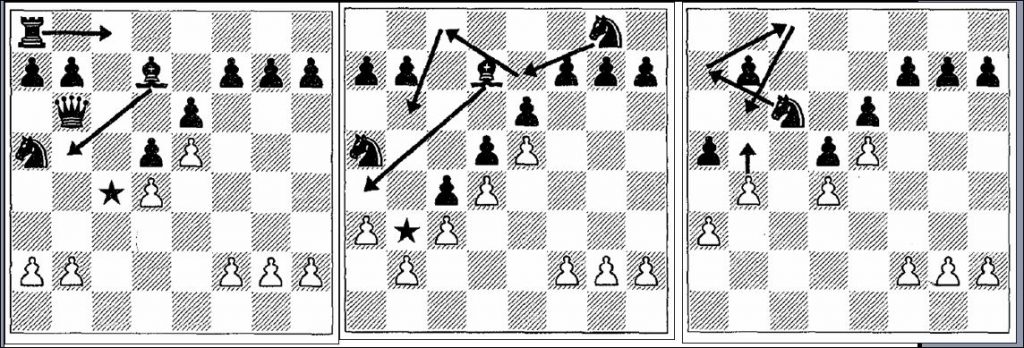
These four visual images should give you an idea of the maneuvers and pawn structures one will encounter in the French Advance. Now watch the games by Sveshnkov and see what you recognize.
There are also GM Soltis, IM Collins who wrote books about the French and others who played it, like GM Psakhis, Korchnoi or Uhlmann. Using Megabase one should watch their games to get a better understanding of the journey ahead!
These are the games selected by GM Lemos for this chapter:
Chapter Nine: The King’s Indian Attack
On this opening system has been written few books. Fischer was also using it as system probably to avoid to study theory, and then he had to give up, and prepare for each of Black’s defenses. Recently a Romanian female chess player advised this system in a series of videos. It can be dangerous, it needs to be studied seriously.
This is the selection given by GM Lemos for this chapter:
The book ends with an index of variations, which I consider very important, because one can use it to look for more games played with those lines, or used it as a guide in correspondence games. And the final pages are an index of the games, also useful to spot recurrent names.
Final thoughts: A big thank to Chessbase is needed, because I used their latest Megabase 2021 (which had many games already annotated!) for researching the games you read in this article, and the author of the book GM Lemos used Chessbase Megadatabase 2020, and Chessbase Database online for writing the book. We should also thank Stockfish, for example in the game 17 (Chapter 4 Ivanchuk vs Carlsen) one of the critical moves not found by Carlsen during the game, was found in less than 1 second by Stockfish.
The book annotates some beautiful games like Predojevic vs Morozevich, where Morozevich castled at move 30! But this seems a pattern with the French, also the game Kasparov vs Ivanchuk has Black castling at move 31, and winning the game! And what about the game Vitiugov vs Van Foreest? Wasn’t it amazing how a pawn avalanche would beat the bishop pair? It becomes also clear the new players are universal, they don’t stick to one opening, but they continuously try different openings in the attempt to find the point where their usual opponents will break. This makes even more evident the need for books like this one, which can keep our opening weapons always fresh, and sharp! I believe this book is important, because while the engines can give us a perfect evaluation of the position, no mistakes, etc. This book can explain, through the words by GM Lemos, the meaning behind most of the moves played in the games. This human-to-human explanation is what we need to improve our chess skills, and chess understanding.
By the way, it took me more than a month to write this review, and I enjoyed it, thanks to the huge amount of different games I’ve seen. I admit I’ve seen them only on the screen, but once the review is published, I will return to them and play them over the board!
